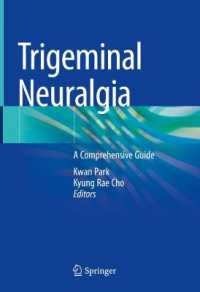Full Description
Movement is the way that animals interact with their environment and is under the organization and complex control of the brain and spinal cord. Multiple central nervous systems, including cortex, basal ganglia, cerebellum, and brainstem, interact to provide precise motor control and integration. Damage or disease within these systems cause profound motor disturbances in man, which can be effectively modeled in animals to develop a better understanding and treatment of the human condition. Animal Models of Movement Disorders introduces a variety of methods and techniques used to model and assess motor function in experimental animals from lower orders, such as drosophila and c. elegans, through vertebrate species including fish, to mammals, such as rodents and non-human primates. The most advanced contemporary models in each system are presented at multiple levels of analysis from molecular and genetic modeling, lesions, anatomy, neurochemistry, to imaging and behavior. Volume II of this detailed collection contains sections on the basal ganglia, neo- and allo-cortical systems, cerebellar and brain stem systems, as well as spinal cord systems.
Comprehensive and meticulous, Animal Models of Movement Disorders serves as a valuable reference for those studying motor disorders by covering methodologies in detail and providing the information necessary to consider both the appropriate models and assessment tools that can most informatively answer the key experimental issues in the field.
Contents
Behavioral Assessment of Genetic Mouse Models of Huntington's Disease.- Excitotoxic Lesions of the Rodent Striatum.- Combination Lesion Models of MSA.- The Role of the Dorsal Striatum in Instrumental Conditioning.- 3-Nitropropionic Acid and Other Metabolic Toxin Lesions of the Striatum.- Functional Assessment of Subcortical Ischemia.- Functional Organization of Rat and Mouse Motor Cortex.- Forebrain Circuits Controlling Whisker Movements.- An Approach to Understanding the Neural Circuitry of Saccade Control in the Cerebral Cortex Using Antidromic Identification in the Awake Behaving Macaque Monkey Model.- Photothrombotic Infarction of Caudate Nucleus and Parietal Cortex.- Models of Rodent Cortical Traumatic Brain Injury.- The Use of Commissurotomy in Studies of Interhemispheric Communication.- Genetic Models of Cerebellar Dysfunction.- Cerebellar Control of Fine Motor Function.- Cerebellum and Classical Conditioning.- Assessments of Visual Function.- The Role of the Pedunculopontine Tegmental Nucleus in Motor Disorders.- Contusion Models of Spinal Cord Injury in Rats.- Demyelination Models in the Spinal Cord.- Preparation of Spinal Cord Injured Tissue for Light and Electron Microscopy Including Preparation for Immunostaining.- Assessing Spinal Cord Injury.- Precise Finger Movements in Monkeys.








